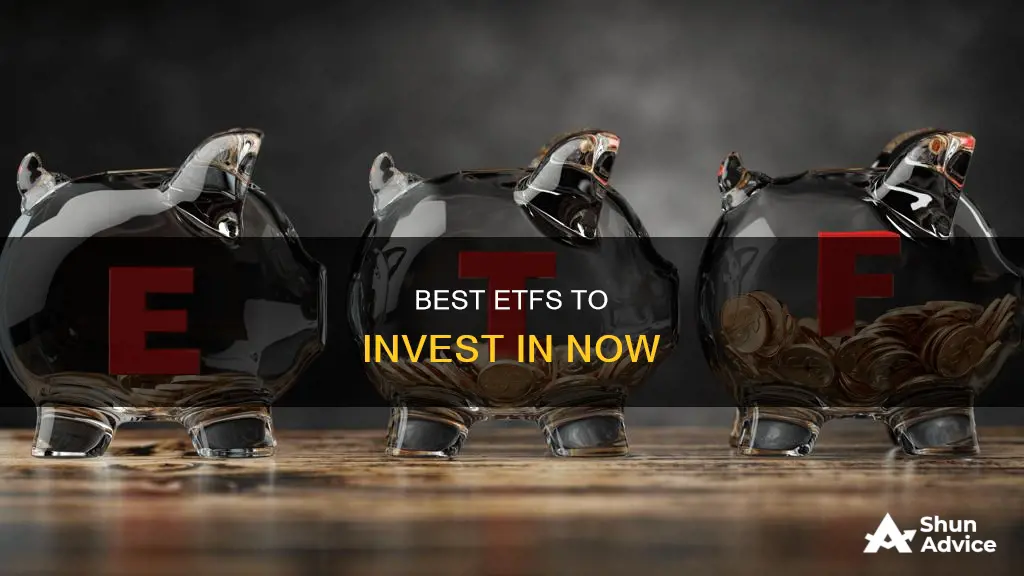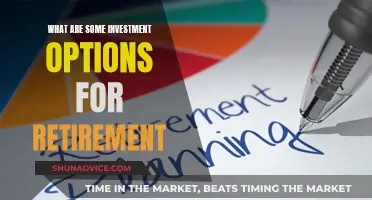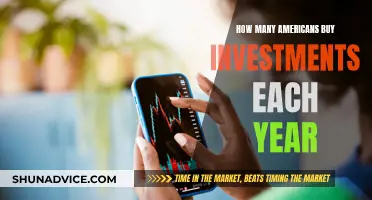
Exchange-traded funds (ETFs) are a great way to diversify your portfolio and gain exposure to a wide range of sectors. With thousands of ETFs to choose from, it can be challenging to know where to start. Here are some factors to consider when deciding which ETF to invest in:
- Performance and Risk: While past performance doesn't guarantee future results, it's worth considering the ETF's long-term performance. Additionally, evaluate the level of risk you're comfortable with. ETFs that focus on specific sectors or industries tend to be more volatile than those that track broad market indexes.
- Expense Ratio: The expense ratio represents the annual fees you'll pay to own the fund, typically expressed as a percentage of your investment. Lower expense ratios are generally preferable as they maximize your returns.
- Diversification: ETFs offer built-in diversification by holding a collection of stocks, bonds, or other assets. However, the level of diversification varies between ETFs. Some ETFs focus on specific sectors or themes, while others provide broader exposure.
- Investment Goals: Consider your investment goals and risk tolerance when selecting an ETF. For example, if you're interested in dividend income, look for ETFs that focus on dividend-paying stocks. If you want international exposure, choose ETFs that invest in companies from different countries or regions.
- Brokerage Account: You'll need a brokerage account to buy and sell ETFs. Many online brokers offer a range of ETFs with low or no transaction fees. Compare the screening tools and investment options provided by different brokers to find the best fit for your needs.
- Vanguard S&P 500 ETF (VOO): Tracks the S&P 500 index, offering broad market exposure with a low expense ratio of 0.03%.
- Invesco QQQ Trust (QQQ): Focuses on large-cap growth stocks, particularly in the tech sector, with an expense ratio of 0.2%.
- iShares Core S&P Small-Cap ETF: Provides diversified exposure to small-cap stocks with a low expense ratio of 0.06%.
- iShares Core Dividend Growth ETF: Invests in U.S. dividend-growing stocks, offering a dividend yield of 2.4% as of mid-2024 and an expense ratio of 0.08%.
- Vanguard Total Stock Market ETF (VTI): Provides exposure to the entire U.S. stock market, including large, mid, and small-cap companies, with a low expense ratio of 0.03%.
- iShares Core MSCI Total International Stock ETF: Offers diversified international exposure with an attractive dividend yield of 3.1% as of mid-2024 and an expense ratio of 0.07%.
What You'll Learn

ETFs for beginners
Exchange-traded funds (ETFs) are an excellent entry point into the stock market for beginners. They are a collection of stocks or other assets, usually with low expenses, that trade on an exchange like stocks. ETFs are a good choice for beginners because they do not require in-depth knowledge of investing or financial markets to be successful.
How to get started with ETFs
Firstly, you will need to open a brokerage account to buy and sell securities like ETFs. Many brokerages have no account minimums, transaction fees, or inactivity fees.
Once you have your brokerage account, you can use screening tools to find and compare ETFs. There are thousands of ETFs listed in the U.S. alone, so screening tools are critical for narrowing down the options. You can filter ETFs based on criteria such as asset type, geography, industry, trading performance, or fund provider.
Some key factors to consider when choosing an ETF include:
- Administrative expenses (expense ratios): The average expense ratio for passively managed funds was 0.12% in 2022, so this is a good number to aim for or go below.
- Commissions: These are fees you pay per transaction when you buy or sell an ETF. Most major online brokers do not charge commissions, but it is worth checking before you buy.
- Volume: This shows how many shares were traded over a given time period and indicates the popularity of a fund.
- Holdings: The individual companies the fund invests in.
- Performance: Compare the long-term performance history (e.g., three-year, five-year, or 10-year) of similar funds.
After you have decided which ETFs to buy, you can place a trade through your brokerage's website.
Recommended ETFs for Beginners
- Vanguard S&P 500 ETF (VOO)
- SPDR S&P 500 ETF Trust (SPY)
- IShares Core S&P 500 ETF (IVV)
- Invesco QQQ Trust (QQQ)
- Vanguard Total Stock Market ETF (VTI)
These ETFs provide instant exposure to a diversified portfolio of stocks and have low expense ratios, making them a good choice for beginners.
Risks and considerations
While ETFs are generally considered safer than individual stocks due to their diversification, it is important to remember that they can still carry risk. The performance of an ETF depends on the weighted average performance of its holdings, so if the ETF holds poorly performing assets, it will also perform poorly. Additionally, ETFs will never be the highest performers due to their diversified nature.
It is also important to consider your investment goals and risk tolerance when choosing ETFs. Different types of ETFs, such as sector-specific or international ETFs, may be suitable for your portfolio depending on your goals and risk tolerance.
Finally, remember that past performance does not guarantee future results. It is essential to do your research and carefully evaluate any ETF before investing.
US Investment Trends: Where's the Money?
You may want to see also

Best ETFs for July 2024
Exchange-traded funds (ETFs) are a great way to invest in a collection of stocks or other assets, usually with low expenses. Here are some of the top ETFs to consider for July 2024:
Vanguard S&P 500 ETF (VOO)
The Vanguard S&P 500 ETF is one of the most popular and well-known ETFs. It tracks the S&P 500 index, giving you exposure to 500 large-cap U.S. stocks. With a low expense ratio of 0.03%, it's a cost-effective way to invest in the broader market.
Invesco QQQ Trust (QQQ)
The Invesco QQQ Trust ETF tracks the Nasdaq-100 index, which includes 100 of the largest non-financial companies on the Nasdaq. With Apple, Microsoft, and Amazon as its top holdings, it offers excellent exposure to big tech stocks. It has a reasonable expense ratio of 0.2%.
Vanguard Total Stock Market ETF (VTI)
If you want exposure to the entire U.S. stock market, the Vanguard Total Stock Market ETF is a great choice. It holds thousands of stocks of all sizes, including large caps, mid caps, and small caps. With a low expense ratio of 0.03%, it's a cost-effective way to diversify your portfolio.
IShares Core S&P Small-Cap ETF (IJR)
For investors seeking exposure to small-cap stocks, the iShares Core S&P Small-Cap ETF is a good option. It provides broad diversification by holding a large number of small-cap stocks, reducing the risk associated with investing in individual small-cap companies. Its expense ratio is 0.06%.
IShares Core Dividend Growth ETF (DGRO)
The iShares Core Dividend Growth ETF focuses on U.S. stocks with a history of growing their dividends. With a trailing 12-month yield of 2.4% and a low expense ratio of 0.08%, it's an attractive option for income-seeking investors.
Vanguard Intermediate-Term Corporate Bond ETF (VCIT)
For those looking to add bonds to their portfolio, the Vanguard Intermediate-Term Corporate Bond ETF is worth considering. It holds investment-grade corporate bonds with maturities between five and ten years. With a low expense ratio of 0.05%, it's a cost-effective way to add bond exposure.
When choosing ETFs, it's important to consider your investment goals, risk tolerance, and the fees associated with each fund. Diversification is also key, and ETFs are a great way to gain exposure to a variety of assets and sectors.
Rich People: The Only Investors?
You may want to see also

How to invest in ETFs
Exchange-traded funds (ETFs) are an excellent entry point into the stock market. They are cheap and typically carry lower risk than individual stocks since a single fund holds a diversified collection of investments. Here are the steps to investing in ETFs:
- Open a brokerage account: You need a brokerage account to buy and sell securities like ETFs. Many brokerages have no account minimums, transaction fees, or inactivity fees.
- Find and compare ETFs with screening tools: There are thousands of ETFs listed globally, so screening tools are critical for finding the ETFs you want. Most brokers offer robust screening tools to filter ETFs based on criteria such as asset type, geography, industry, trading performance, or fund provider.
- Buy the ETF: The process for buying ETFs is similar to buying stocks. Navigate to the "trading" section of your brokerage's website and buy the ETF using its ticker symbol. Be sure to double-check that you have the correct ticker symbol, order type, and share amount before executing your order.
- Sit back and relax: Congratulations, you've just bought your first ETF! These funds can help form the basis of a well-diversified portfolio. There's no need to compulsively check its performance, but you can access that information via your brokerage's website or by typing the ticker symbol into a search engine.
Factors to Consider When Choosing ETFs
When choosing ETFs, it's important to consider the following factors:
- Risk: ETFs are generally considered safer than individual stocks due to their diversification. However, some ETFs can be riskier than others, depending on the types of assets they hold.
- Expense ratio: The expense ratio is the amount you'll pay in fees annually to own the fund. A lower expense ratio is generally preferable as it will eat less into your returns.
- Performance: While past performance doesn't guarantee future results, it can be useful to compare the performance history of similar funds. Look at the fund's long-term performance (e.g., three-year, five-year, or ten-year) to get a sense of how it has performed over time.
- Holdings: Consider the individual companies the fund invests in. Are they aligned with your investment goals and risk tolerance?
Examples of ETFs to Consider
- Vanguard S&P 500 ETF (VOO): Tracks the S&P 500 index, providing exposure to 500 large U.S. companies.
- Invesco QQQ Trust (QQQ): Tracks the Nasdaq-100 Index, which includes tech and growth stocks.
- Vanguard Russell 2000 ETF (VTWO): Tracks the Russell 2000 Index, providing exposure to small-cap U.S. companies.
- Vanguard High Dividend ETF (VYM): Focuses on stocks that pay above-average dividends.
- Vanguard Total World Bond Fund (BNDW): Includes international bonds and U.S. bonds of various lengths and maturities.
Immaterial Labor: Why Invest?
You may want to see also

Top ETFs for long-term gains
Exchange-traded funds (ETFs) are a great way to diversify your portfolio and gain exposure to a wide range of sectors. They are also a good entry point for beginner investors who want to invest in the stock market. Here are some of the top ETFs for long-term gains:
Vanguard S&P 500 ETF (VOO)
VOO is one of the largest and most popular ETFs, tracking the S&P 500 index. It offers instant diversification by giving you exposure to 500 large-cap U.S. stocks. With an expense ratio of just 0.03%, it is a low-cost option for investors. The ETF has a strong track record, delivering an average annual return of 15.2% over the last five years.
Invesco QQQ Trust (QQQ)
The Invesco QQQ Trust ETF tracks the Nasdaq-100 index, which includes 100 of the largest non-financial companies on the Nasdaq. With Apple, Microsoft, and Amazon as its top holdings, this ETF provides exposure to some of the biggest names in the tech industry. The fund has generated strong returns, outpacing the S&P 500 with a total return of over 920% since its launch in 1999.
Vanguard Growth ETF
The Vanguard Growth ETF is another great option for investors looking to invest in large-cap growth stocks. It tracks the CRSP US Large-Cap Growth index and has Apple and Microsoft as its top holdings. With an expense ratio of just 0.04%, it is a low-cost option for investors seeking growth.
IShares Core S&P Small-Cap ETF
This ETF provides broad exposure to small-cap stocks, which tend to be more volatile than large-cap stocks. By owning a large basket of small-cap stocks, this ETF helps to reduce the risk associated with investing in smaller companies. It has a very low expense ratio of 0.06%, making it an affordable option for investors seeking small-cap exposure.
IShares Core Dividend Growth ETF
The iShares Core Dividend Growth ETF provides exposure to U.S. stocks with a history of growing their dividends. Dividend stocks have outperformed the broader market over the last 50 years, making them a great long-term investment. This ETF has a trailing 12-month yield of 2.4% and a low expense ratio of 0.08%, making it an attractive option for dividend income.
Vanguard Total Stock Market ETF (VTI)
The Vanguard Total Stock Market ETF provides exposure to the entire U.S. stock market, including large, mid, and small-cap companies. With over 3,700 stocks in its portfolio, it offers true diversification. The ETF has a low expense ratio of 0.03%, making it an affordable way to invest in the U.S. stock market.
IShares Core MSCI Total International Stock ETF (IXUS)
For investors seeking international exposure, the iShares Core MSCI Total International Stock ETF is a good option. It holds almost 4,400 stocks of all sizes from around the world, providing diversified exposure to international markets. The ETF has an expense ratio of 0.07% and offers an attractive dividend yield of 3.1%.
Investing: Why the Delay?
You may want to see also

ETFs vs. mutual funds
When considering what ETF to invest in, it is worth knowing the differences between ETFs and mutual funds. While they are similar in structure and benefits, there are some key differences to be aware of.
ETFs and mutual funds both represent professionally managed collections, or "baskets", of individual stocks or bonds. They are both less risky than investing in individual stocks and bonds and they both offer a wide variety of investment options. They are also both overseen by professional portfolio managers.
However, ETFs are usually passive investments, meaning they just follow a predetermined index and invest mechanically based on whatever is in that index. Mutual funds, on the other hand, are often actively managed, meaning a fund manager is investing the money, ideally to beat the market. ETFs are also often cheaper than mutual funds, as passive investing is cheaper to set up than active management. ETFs are also more liquid than mutual funds, as they can be traded at any point during a trading session, whereas mutual funds can only be traded once daily. Mutual funds may also be subject to a penalty of up to 2% of the share value for selling early. ETFs also do not have sales loads, which are commissions paid to the salesperson, whereas mutual funds may have these.
In terms of which ETF to invest in, there are a few top-performing funds to consider. The Vanguard S&P 500 ETF (VOO) is one of the largest funds on the market, having been backed by Vanguard, one of the powerhouses of the fund industry. The SPDR S&P 500 ETF Trust (SPY) is the granddaddy of ETFs, having been founded back in 1993. The Invesco QQQ Trust (QQQ) is another top-performing ETF that focuses on technology and growth companies. The Vanguard Total Bond Market ETF (BND) gives investors exposure to a wide selection of bonds, and the Vanguard Total Stock Market ETF (VTI) effectively covers the entire universe of publicly traded stocks in the U.S.
Investing: Fear or Loathing?
You may want to see also
Frequently asked questions
Here are some of the best ETFs to buy now, according to U.S. News:
- ProShares Bitcoin Strategy ETF (BITO)
- VanEck Semiconductor ETF (SMH)
- Global X Copper Miners ETF (COPX)
- abrdn Physical Silver Shares ETF (SIVR)
- First Trust RBA American Industrial Renaissance ETF (AIRR)
- Invesco S&P MidCap Momentum ETF (XMMO)
- Invesco S&P 500 Momentum ETF (SPMO)
ETFs can be some of the best investments for beginners. They are relatively inexpensive, available through robo-advisors and traditional brokerages, and tend to be less risky than investing in individual stocks. Some of the best ETFs for beginners include:
- Vanguard S&P 500 ETF (VOO)
- SPDR S&P 500 ETF Trust (SPY)
- iShares Core S&P 500 ETF (IVV)
- Schwab S&P 500 Index Fund (SWPPX)
ETFs provide several benefits to investors, including:
- The ability to buy multiple assets in one fund
- The risk-reducing benefits of diversification
- Generally low costs to manage the fund
Some of the best ETFs for long-term investing include:
- Vanguard S&P 500 ETF
- Invesco QQQ Trust
- Vanguard Growth ETF
- iShares Core S&P Small-Cap ETF
- iShares Core Dividend Growth ETF
- Vanguard Total Stock Market ETF
- iShares Core MSCI Total International Stock ETF







